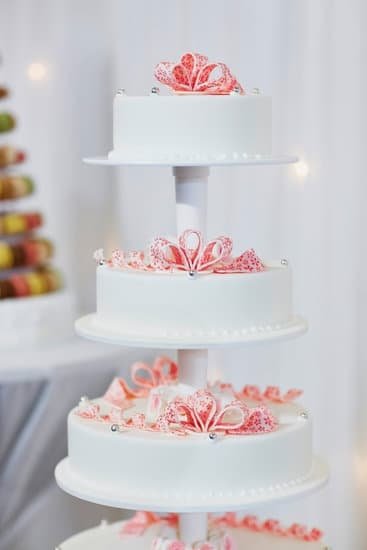Are you looking for a unique way to elevate your cake decorating skills? Learn how to decorate a cake with greenery and create a stunning visual appeal that will impress your guests. Greenery has become a popular trend in cake decoration, adding a natural and earthy touch to any sweet creation. In this article, we will explore the art of using greenery to adorn cakes, from choosing the right types of greenery to safety precautions and showcasing your beautiful creations.
The use of greenery in cake decoration has gained popularity due to its ability to add a fresh and natural element to cakes. Whether it’s for weddings, birthdays, or any special occasion, incorporating greenery into cake designs can create a visually striking and elegant look. From simple accents to elaborate arrangements, greenery can instantly transform an ordinary cake into a show-stopping centerpiece.
In the following sections, we will delve into the various aspects of decorating cakes with greenery. We will provide tips on choosing the right types of greenery, preparing them for safe use on cakes, different decorating techniques, as well as discussing the pros and cons of using edible versus non-edible greenery.
So if you’re ready to take your cake decorating skills to the next level, read on for everything you need to know about using greenery in cake decoration.
Choosing the Right Greenery
When it comes to decorating a cake with greenery, choosing the right type of greenery is essential to achieving a visually appealing result. Here are some tips on selecting the best types of greenery for cake decoration:
1. Eucalyptus: Known for its delicate leaves and subtle fragrance, eucalyptus is a popular choice for cake decoration. Its pale green color and elegant shape make it a versatile option for both rustic and modern cake designs.
2. Rosemary: With its slender, needle-like leaves and earthy fragrance, rosemary is a great choice for adding texture and depth to cake decorations. It pairs well with floral arrangements and adds a pop of freshness to any cake design.
3. Ferns: Ferns come in a variety of shapes and sizes, making them an ideal option for creating intricate and eye-catching cake decorations. Whether you opt for delicate maidenhair ferns or bold sword ferns, these plants add a touch of natural charm to any cake.
When selecting greenery for cake decoration, it’s important to consider the overall theme and aesthetic of the cake. Whether you’re aiming for a minimalist look or an elaborate design, choosing the right greenery can enhance the visual appeal of your creation.
To ensure that your chosen greenery is safe to use on a cake, it’s crucial to carefully inspect each leaf or sprig before incorporating it into your design. Look out for wilting or discoloration, as these could indicate that the greenery is not suitable for use on food items.
Remember that not all types of greenery are safe for consumption. Be sure to research each type of plant before using it as a decorative element on your cake. If you have any doubts about the safety of a particular plant, it’s best to err on the side of caution and opt for artificial alternatives.
By carefully selecting the right type of greenery for your cake decoration and ensuring its safety, you can create stunning and unique designs that will wow your guests and elevate any special occasion.
Preparing the Greenery
When it comes to decorating a cake with greenery, proper preparation of the greenery is essential to ensure both safety and visual appeal. Here is a step-by-step guide on how to clean, trim, and prepare the greenery for safe use on a cake.
Cleaning the Greenery
Before using any greenery on a cake, it’s crucial to thoroughly clean it to remove any dirt, dust, or potential contaminants. The best way to clean the greenery is by gently washing it in cool water and then patting it dry with paper towels. Be sure to handle the greenery carefully to avoid damaging delicate leaves or stems.
Trimming and Preparing the Greenery
Once the greenery is clean and dry, it’s time to trim and prepare it for decorating the cake. Using sharp scissors or floral shears, carefully trim any excess stems or leaves that may not be needed for your design. It’s also important to check for any brown spots or wilting on the greenery and remove those areas to ensure that only fresh and vibrant pieces are used.
Safety Considerations
When selecting greenery for cake decoration, it’s essential to ensure that the chosen plants are food-safe and free from any toxic substances. Avoid using any greenery that has been treated with pesticides or other chemicals. Additionally, be mindful of allergies – some individuals may have sensitivities to certain types of plants, so always consider your guests’ dietary restrictions before adorning a cake with greenery.
By following these steps for preparing the greenery for your cake decoration, you can create a stunning and safe masterpiece that will surely be the centerpiece of any celebration. Now that you have prepared your greenery, it’s time to explore various decorating techniques on how to incorporate them onto your cake.
Decorating Techniques
One of the more popular trends in cake decoration involves incorporating greenery into the design. When considering how to decorate a cake with greenery, there are various techniques that can be used to create stunning and visually appealing designs. One option is to have the greenery cascade down the sides of the cake, creating a beautiful and natural look.
Another technique is to create a wreath of greenery around the top or bottom of the cake, adding an elegant and organic touch to the design. Additionally, adding small sprigs of greenery as accents throughout the cake can create a cohesive and harmonious look.
Adding Greenery Cascading Down the Sides
When opting for a cascading effect, it’s important to choose types of greenery that will hold up well and maintain their shape. Eucalyptus, ivy, or ferns are great options for this type of decoration. Begin by selecting long stems with healthy leaves still attached. Trim these lengths to fit around each tier of the cake and ensure that they drape naturally down its sides.
Creating a Wreath With Greenery
For creating a wreath around the tiers of your cake, consider using flexible types such as rosemary or olive branches which are easier to manipulate into a circular shape. Start by gently wrapping each stem or branch around one another until you’ve formed a complete circle that can be placed on top or bottom tiers.
| Greenery Techniques | Recommended Greenery Options |
|---|---|
| Cascading Down The Sides | Eucalyptus, Ivy, Ferns |
| Creating A Wreath | Rosemary, Olive Branches |
Edible vs Non-Edible Greenery
When it comes to decorating a cake with greenery, one of the main decisions to make is whether to use real edible greenery or artificial greenery. Each option has its own set of pros and cons, so it’s important to consider these factors before making a decision.
Edible Greenery
Using real edible greenery, such as herbs like rosemary and thyme, can add a natural and organic touch to a cake. Not only does it enhance the visual appeal of the cake, but it also adds a subtle flavor that complements the overall taste. Additionally, edible greenery is completely safe for consumption, making it a popular choice for many bakers.
However, there are some drawbacks to using real edible greenery on cakes. Firstly, not all types of edible greenery are suitable for use on cakes and may not hold up well under certain conditions. It’s also important to ensure that the edible greenery is thoroughly cleaned and free from any pesticides or contaminants before using it on a cake.
Non-Edible Greenery
On the other hand, artificial greenery offers its own set of advantages. It is readily available in various forms and can be easily manipulated to achieve specific designs and arrangements. Artificial greenery also does not wilt or dry out like real greenery, making it a more reliable option for long-lasting decorations.
Despite these benefits, there are some downsides to using non-edible greenery on cakes. The most obvious drawback is that artificial greenery is not meant for consumption and must be removed before serving the cake. Additionally, some artificial materials may not be food-safe or may contain chemicals that could potentially leach onto the cake.
Ultimately, whether you choose to use real edible greenery or artificial greenery for cake decoration will depend on your specific needs and preferences. Both options offer unique benefits and considerations that can elevate the overall look of your cake – just remember to take into account factors such as taste, safety, and visual impact when making your decision on how to decorate a cake with greenery.
Adhering the Greenery
When it comes to decorating a cake with greenery, one of the most crucial steps is safely attaching the greenery to the cake. There are various methods for doing this, but two popular options are using edible glue or floral tape. These methods ensure that the greenery stays in place while also being safe for consumption.
Edible glue is a simple and effective way to adhere greenery to a cake. It can be easily purchased at baking supply stores or made at home using ingredients like powdered sugar and water. To use edible glue, simply apply a small amount to the back of the greenery and gently press it onto the cake. This method is ideal for delicate leaves and flowers as it provides a secure hold without damaging the greenery.
Floral tape is another great option for attaching greenery to a cake. This special tape is designed for use with fresh flowers and foliage, making it a safe choice for decorating cakes. To use floral tape, carefully wrap it around the stems of the greenery, ensuring that it stays in place without coming into direct contact with the cake. This method is particularly useful when creating cascading designs or intricate arrangements on cakes.
In addition to using these methods, it’s important to remember that when decorating a cake with greenery, only certain types of plants should be used due to potential toxicity concerns. Always ensure that any greenery used on a cake is food-safe and free from pesticides or chemicals before applying it to your creation.
| Method | Description |
|---|---|
| Edible Glue | A simple and effective way to adhere delicate leaves and flowers without damaging them. |
| Floral Tape | A special tape designed for use with fresh flowers and foliage, perfect for creating cascading designs or intricate arrangements on cakes. |
Safety and Precautions
When using greenery for cake decoration, it is important to prioritize food safety and handling. It is essential to remember that while greenery can add a beautiful, natural touch to a cake, it must be used safely to avoid any risk of contamination. Here are some important reminders about food safety and handling when using greenery on cakes:
- Choose edible greenery: When decorating a cake with greenery, it is crucial to ensure that the chosen greenery is safe for consumption. Avoid using toxic plants or chemically treated foliage that may pose a health risk.
- Thoroughly clean the greenery: Before using any greenery on a cake, make sure to wash and rinse it thoroughly. This will help remove any dirt, dust, or contaminants that may have come into contact with the foliage.
- Avoid direct contact with the cake surface: When placing the greenery on the cake, take care to avoid direct contact between the foliage and the actual cake surface. Using a barrier such as parchment paper underneath can help prevent any potential transfer of unwanted elements onto the cake.
In addition to these precautions, it is important to handle the greenery with clean hands and tools to minimize any risk of contamination. By following these safety guidelines, you can ensure that your decorated cake not only looks visually appealing but also remains safe for consumption.
Lastly, when displaying a cake decorated with greenery, be mindful of where it is placed. Keep in mind factors like temperature, humidity, and exposure to sunlight that could affect the freshness and appearance of the greenery over time. With these safety precautions in mind, you can confidently showcase your beautifully adorned cake without compromising on food safety standards.
By prioritizing food safety and handling when using greenery on cakes, you can create stunning and safe decorative pieces that are sure to impress at any event or celebration.
Showcasing Your Creation
In conclusion, decorating a cake with greenery can add a beautiful and natural touch to any occasion. Whether it’s for a rustic wedding, a garden-themed birthday party, or just a special dessert for any event, the use of greenery on cakes has become an increasingly popular trend. By following the tips outlined in this article, you can easily elevate your cake decorating skills and impress your guests with stunning and visually appealing creations.
When showcasing your creation, it’s important to consider the overall aesthetic you want to achieve. Whether you choose to adorn your cake with cascading greenery down the sides, create a delicate wreath around the top, or simply add small sprigs as accents, the presentation of your decorated cake will greatly impact its visual appeal. By carefully arranging the greenery and paying attention to detail, you can create a truly stunning centerpiece for any occasion.
Remember to always keep safety and food handling in mind when decorating a cake with greenery. If using real edible greenery, make sure it is thoroughly cleaned and safe for consumption. Additionally, if using artificial greenery, ensure that it is non-toxic and food-safe. By adhering to these guidelines and taking into consideration all aspects of the decorating process, you can confidently showcase your beautifully decorated cake with greenery for maximum visual impact at any event.
Frequently Asked Questions
What Kind of Greenery Can You Put on a Cake?
Greenery that can be put on a cake includes edible options like mint leaves, basil, or even microgreens. Non-edible options such as artificial greenery or flowers made of sugar are also popular choices for cake decoration.
What Is the Best Safe Greenery for Cakes?
The best safe greenery for cakes is usually edible greenery such as herbs like rosemary, thyme, or even small edible flowers. It’s important to ensure that any greenery used is free from pesticides or other harmful chemicals.
How Do You Decorate a Cake With Leaves?
Decorating a cake with leaves can be done by placing them strategically around the edges of the cake or cascading down the sides for a more whimsical look. Adding different shades of green and varying sizes of leaves can create a beautiful and natural effect on the cake.
Using edible gold or silver luster dust to add shimmer to the leaves can also elevate the overall aesthetic of the cake decoration.

Welcome to our cake decorating blog! My name is Destiny Flores, and I am the proud owner of a cake decorating business named Cake Karma. Our mission is to provide delicious, beautiful cakes for all occasions. We specialize in creating custom cakes that are tailored specifically to each customer’s individual needs and tastes.





